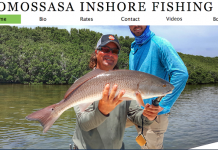Winter fishing patterns prevailed once again at the mouth of Tampa Bay, and some anglers were even able to take limits of cool water species at the Sunshine Skyway Fishing Piers. Sheepshead retained their top-billing at the piers with past week, with several anglers putting in the time to take a cooler full of these convict fish. Whiting were on a good bite once again and were joined by some silver trout on various occasions. Spotted trout were taken in the tollbooth areas this past week and a few keeper specks were even mixed into the deeper-water whiting fishery. Grunts and porgies continued on the reefs and some mangrove snapper occasionally joined this rock bite. After dark and in the very early morning hours, ladyfish and bluefish were taken along the approach sections. Finally, massive schools of cownose rays weaved their way through the pier structure and had some followers like cobia and small sharks.
Anglers in pursuit of sheepshead had some banner days this past week, and a few willing to put in the time & effort were able to take a full limit of this great-tasting porgy. Some fish are on nearly every pier piling at this time, but the approach sections and bathroom areas remained the best locations for numbers of fish. The old standby rig of 15 lb. test fluorocarbon leader, a large split-shot sinker, and a size #1 or #2 bait-holder hook was most commonly used. Sheepshead, however, bring out the rigging guru in almost any angler that enjoys targeting these fish. Some anglers like a 1/2 oz. egg sinker rigged knocker-style right to the hook while others use a 1/4 oz. or 3/8 oz. plain lead head jig as their only terminal take. Suffice it to say that whatever triggers the most bites and lands the most fish for your personal style is what should be used. The same can be said for bait because everything took fish at certain times this past week. Fiddler crabs & sand fleas were both successful creepy-crawlers used as bait, but small bits of fresh or freshly-frozen shrimp also did very well. For any sheepshead bait, just use enough to cover the hook, because often additional portions standing off are simply picked-away without even a chance for a hook set.
Whiting were on another good bite this past week and surpassed silver trout as the most common catch for anglers probing the end section of each fishing pier. Most whiting taken at the piers are only about a foot long, but what they lack in size, they compensate for with aggressiveness and fine eating qualities. The methods for whiting are too numerous to list, but slowly bouncing a rig with multiple hooks on the bottom continued to take the most fish. Such rigs can be tandem jig rigs, larger sized sabiki-style baitfish rigs, or simply smaller versions of multiple-hook “chicken rigs” used by offshore anglers. Strips of cut bait can be added to increase the number of bites. Of course, single hook rigs will work as well, but these fish often school up & feed in unison, so the multiple-hook rigs capitalize on their tendencies. Whiting have mild, white flakey-flesh that suits a wide variety of fish recipes. Indeed, the fish has been commonly caught & sold commercially for many years in the northern states.
Ladyfish and bluefish were hitting baitfish schools during the overnight hours on the pier approach sections. The bite tended to start near sundown and continued into the first portion of daylight. Most fish were taken by visitors who commonly jig fish these sections for pompano, but some anglers began to target these fish specifically with natural bait methods. Small shrimp or scaled sardines were drifted in or out with the tidal flow behind a float and with just a few split-shot sinkers to keep the bait right below the surface. Occasionally the float was “popped” with a jerk of the rod and this often seemed to attract these aggressive species. A few anglers also had fun fishing surface plugs, and some even tied a jig-dropper line to the rear hook in order for a shot at doubles. Ladyfish are popular for making fried fish patties and bluefish are often sought for casseroles & chowders, so both species have select culinary followings that find them valuable.
The cownose ray is one of the most common aquatic visitors to the Sunshine Skyway Fishing Piers, especially from winter into spring, as these rays form large schools in anticipation of breeding. The ray has a broad & flat snout and is generally medium to light tan in coloration with a white underside. Cows feed slightly different than some other rays in that they will search for food sources at various portions of the water column, as opposed to feeding only on the bottom. This means that they often hit lures and/or baits intended for other fish species. Cownose rays have several levels of importance for pier visitors. First and foremost, these rays (especially when schooling) stir up vast portions of the bottom, and are thus followed by a wide variety of predators like cobia, sharks, and pompano. Next, many anglers favor these rays as amongst the best available shark baits to be caught in the Gulf. Finally, there is a collection of pier visitors who enjoy eating these rays by bleeding, filleting the meat off each wing, and then sautéing small round cuts like scallops in butter & garlic.
- The Skyway, Paul Bristow - August 24, 2018
- The Skyway, Paul Bristow - August 17, 2018
- The Skyway, Paul Bristow - August 10, 2018











